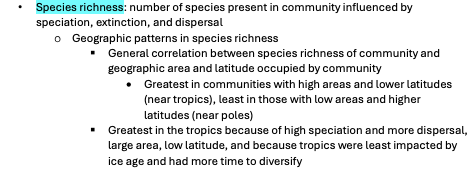Module 5, chapter 54 (communities)
1/13
There's no tags or description
Looks like no tags are added yet.
Name | Mastery | Learn | Test | Matching | Spaced |
|---|
No study sessions yet.
14 Terms
What are species interactions?

What are the 4 major types of interactions?
Commensalism
Consumption
Mutualism
Competition
Define commensalism
+/0
One species benefits and the other is unaffected
Can be parasitic or mutualistic
Define consumption, including the 3 sub-types.
+/–
One organism eats or absorbs nutrients from another, increasing the consumers fitness but decreasing the victims fitness
3 types:
Predation: predator kills all or most of prey
Fatal to victim– all or most of tissue consumed
Predators ae typically carnivores, but seed predators consume and kill plant embryos (herbivory)
Herbivory: consumes plant/algae tissue such as leaves, stems, fruits, or roots, but typically not entire organism
May or may not be fatal to victim depending on extent of damage; apical meristem facilitates recovery
Parasitism: organism lives in/on a host and takes its resources
Usually not fatal because they tend to be small relative to host, but can decrease fitness
Define mutualism. Discuss the ant-acacia tree mutualism example and how it was disturbed.
+/+
Two species interact in a way that grants fitness to both
Fitness benefits range from survival to reproductive related factors
Depending on context, can become parasitic or commensal
Ex. Ants live in acacia trees: the ants protect the tree, and the tree provides food for the ants
The presence of the big-headed ants in Kenya disrupted this, which led to increased herbivory by elephants and increased landscape visibility. As a result, lions were less likely to kill zebras, and their prey species shifted from zebra to buffalo
Define competition, include the 2 sub-types.
–/–
Two species compete for the same resources, which lowers fitness for both
2 types:
Intraspecific competition: competition between members of same species
Major cause of density dependent growth: competition increases as density increases
Interspecific competition: competition between members of different species
Niche differentiation: two species with overlapping niches are able to coexist by shifting niches such that they no longer overlap
Character displacement: changes in a species’ traits that enable species to exploit different resources
List the mechanisms of defense used by prey.
Mechanical defense: use physical structures to deter predators
Chemical defense: produce toxins/noxious chemicals to ward off predators
Aposematic coloration: bright warning colors signaling toxicity/danger
Batesian mimicry: harmless species imitates warning signals of harmful one
Mullerian mimicry: two harmful species evolve to look alike
Cryptic coloration: Camouflage that helps organisms blend into their
Define species richness, its trends, and its pertinence to the tropics.

Define species evenness. What is the diversity stability hypothesis?

Define species composition.

Factors impacting diversity: discuss species and impact, specifically keystone species.

Factors impacting diversity: discuss disturbance.

What does the intermediate disturbance hypothesis say?
Moderate levels of disturbance foster greater levels of diversity than do high or low levels
High disturbance: excludes many slow growing species
Low disturbance: allow competitively dominant species to exclude less competitive species
What does the Island biogeography model say?
